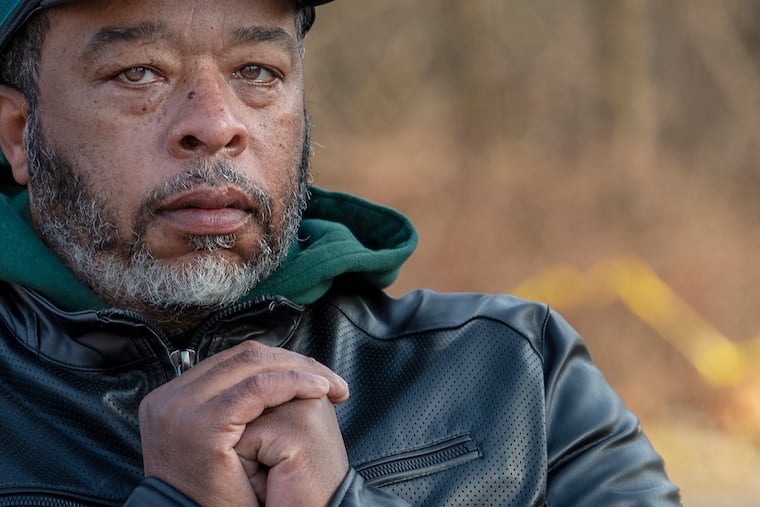No lights, no sidewalks: A deadly bus stop needs big improvements from SEPTA | Helen Ubiñas
A Philadelphia man’s mother was killed by a hit-and-run driver near a dangerous bus stop. Now, he’s calling for change.

“What’s the speed limit?” I asked Stanley Kee as we dodged cars to cross four lanes of traffic on Crescentville Road in Philadelphia’s Oak Lane neighborhood.
“What speed limit?” Kee responded, urging me to be careful.
Across the street, a fading SEPTA sign in the middle of the block between Cheltenham and Adams Avenues designated the area a stop on the Route 57 bus to the Fern Rock Transportation Center.
But this patch of dirt, littered with empty soda bottles and crumpled candy wrappers, that backs up to Tacony Creek — with no sidewalk, no stoplights, and no crosswalk — has no business being marked a bus stop, not a safe one anyway.
And remnants of yellow police tape wrapped around the bottom of the pole should serve as a grim reminder of the inherent contradictions of having a city and a transit system that insist safety is their top priority, but whose decision to place a bus stop on this deadly stretch of roadway suggests otherwise.
Just before 7 p.m. on Jan. 7, Stanley’s mother, 64-year-old Angela Kee, was struck and killed on this street by a hit-and-run driver. While the police investigation is ongoing, Stanley Kee and his family believe his mother, who was on the telephone with a relative as she was about to get off the bus, was hit as she was making her way to her home at the Tacony Crossing apartment complex, right across the street.
“I just don’t know what the city is thinking with this stop,” Kee said, pulling up photo after photo of his mother on his phone. “She was the joy of my heart. My confidante.”
Stanley Kee, 48, was his mother’s only son. He said that his mom — a teacher at a private kindergarten program — had only begun riding the bus in recent months after her car broke down.
He can only shake his head as he remembers now that she was the one who would often remind him to be careful if he ever had to take the bus to his job as a security guard.
It is unclear if any surveillance cameras in the area captured the accident, but initial police reports indicated that there was a witness and that the vehicle that struck Angela Kee — a silver sedan, possibly a Chrysler — was last seen heading north on Crescentville Road. The driver has not yet been identified, but Melany Nelson, of Northwest Victim Services, has been helping the Kee family and trying to call attention to the case.
Some things, though, no one needs a police investigation to know — and one of them is that this stretch of road is dangerous, to pedestrians and bus riders alike, with cars speeding by in both directions to make the lights at adjacent intersections.
Designating a shoulderless side of a heavily traveled road as a bus stop, without even the most basic safeguards, is misguided, if not outright negligent. How about a bench, or a transit shelter of some sort to protect people from drivers who wouldn’t have a clue that was a bus stop as they sped by?
For their parts, both the city, which is responsible for maintaining bus stops on their property, and SEPTA, charged with evaluating the sites, acknowledged that the stop was “less than ideal.”
There just didn’t seem to be a whole lot of urgency to do something about a situation that’s a clear and present danger to SEPTA riders at bus stops like this across the region.
“I don’t think that there’s anything we can do that would make an immediate difference at that location,” SEPTA spokesperson Andrew Busch said when I asked about short-term fixes while the city and SEPTA officials reevaluate the Crescentville Road site. He estimated 70 people use the stop every day.
“Our hearts are with the family,” Busch said, but there are numerous factors that need to be considered when adding or eliminating stops.
“It’s a balance,” he said, pointing to safety and rider demand.
And I get that — to a point. Access to transportation is a vital part of any livable community. But people shouldn’t have to choose between their right to basic infrastructure and their lives.
In an emailed statement sent by a city spokesperson, the city’s Office of Complete Streets said they agreed the bus stop needs to be in a safer location.
“We work with SEPTA to ensure that bus stops are in locations with sidewalks and crosswalks whenever possible,” the statement read. “We know we can save lives by continuing to make common-sense changes to our street system that prioritize the safety of people in our roadways regardless of how they travel.”
No matter what the investigation into Angela Kee’s death concludes, something needs to be done — now — to prevent what are seemingly avoidable tragedies.
After posting a video on Twitter of Stanley Kee pleading for help at the bus stop, responses poured in from residents and fellow transit users who pointed to other dangerous transit stops all over the city. They also sympathized with a son who has put his grief on hold to advocate for the kind of safeguards that might have spared his mother’s life.
“My mother used to say, ‘You let something bad happen once, it will happen twice and then over and over again,’” Kee said. “I don’t want this to happen to no one else. I don’t want no one to feel this pain.”